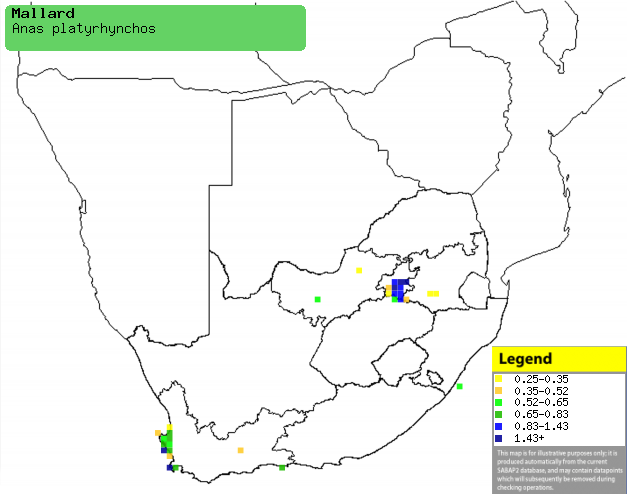|
Anas platyrhynchos
(Mallard)
Groenkopeend [Afrikaans]; Wilde eend [Dutch];
Canard colvert [French]; Stockente [German]; Pato-real [Portuguese]
Life
> Metazoa (Animals) > Phylum:
Chordata
> Vertebrata > Class:
Aves (birds) > Order: Anseriformes
> Family: Anatidae
Distribution and habitat
Occurs across much of the Northern Hemisphere, largely
excluding high mountains, deserts and tundra of the Arctic Circle,
while also breeding in the area from Morocco to Algeria, heading to Sudan and
Ethiopia in the non-breeding season. It is present in the Western Cape and Gauteng, but both populations are feral birds which probably escaped from
wildfowl collections. It generally prefers freshwater wetlands, sewage ponds and
irrigation ponds; it is tolerant of disturbance by humans.
|
 |
|
Distribution of Mallard in southern Africa,
based on statistical smoothing of the records from first SA Bird Atlas
Project (©
Animal Demography unit, University of
Cape Town; smoothing by Birgit Erni and Francesca Little). Colours range
from dark blue (most common) through to yellow (least common).
See here for the latest distribution
from the SABAP2. |
Movements and migrations
Its movements in South Africa are not well
understood, however it is though to be largely sedentary.
Food
Omnivorous, feeding on a variety of insects and other
invertebrates, as well as fish, amphibians and plant matter. It does most of its foraging by
plucking food from the ground or water, often dabbling and up-ending. The following food items have been recorded
in its diet:
- Invertebrates
- insects
- molluscs
- crustaceans
- annelids
- Vertebrates
- Plants
Breeding
- Not studied in southern Africa, so most of the following information comes
from observations in Europe.
- Monogamous, solitary nester, with pairs staying together for only a
single breeding season, during which they perform elaborate and complex courtship displays.
- The nest is built solely by the female, consisting of a shallow
depression with a rim of grasses, leaves and small twigs, well-lined with
soft down and typically placed in dense vegetation near water. It may
occasionally use a nest box or tree cavity instead of building its own nest.
- It lays 4-18 eggs, which are incubated solely by the female for 24-32
days.
- The chicks leave the nest within 14-21 hours of hatching, lead by the female to the
water. She cares for and feeds them in the water until they take their first flight
at 50-60 days old, at which point they become fully independent
Threats
Not threatened, in fact it is widespread and common.
References
-
Hockey PAR, Dean WRJ and Ryan PG 2005. Roberts
- Birds of southern Africa, VIIth ed. The Trustees of the John Voelcker
Bird Book Fund, Cape Town.
|
